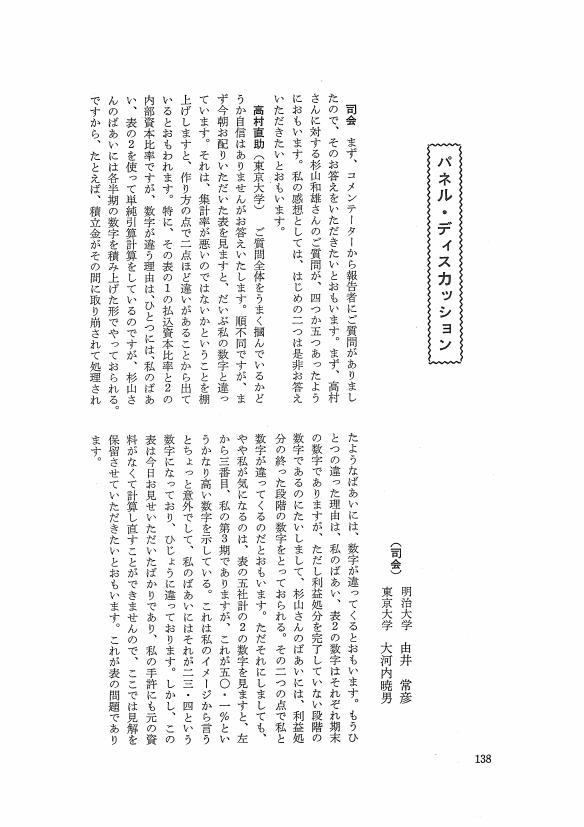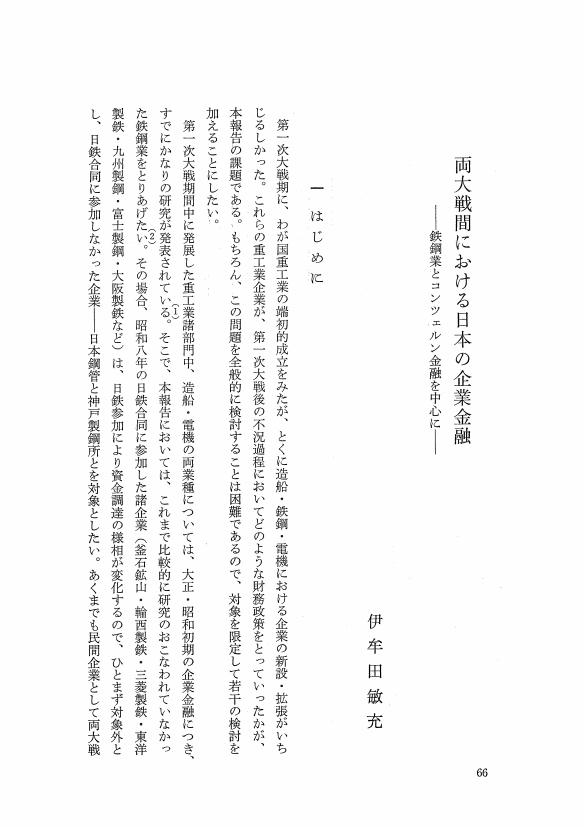1 0 0 0 OA 一九七七年度ビジネス・ヒストリー・コンファレンスに出席して
- 著者
- 安岡 重明 川辺 信雄
- 出版者
- 経営史学会
- 雑誌
- 経営史学 (ISSN:03869113)
- 巻号頁・発行日
- vol.12, no.2, pp.84-91, 1978-03-15 (Released:2010-11-18)
1 0 0 0 OA アメリカにおける経営史研究の一動向
1 0 0 0 OA 形成期イギリス綿紡績株式会社の経営体質
- 著者
- 米川 伸一
- 出版者
- 経営史学会
- 雑誌
- 経営史学 (ISSN:03869113)
- 巻号頁・発行日
- vol.12, no.2, pp.1-27,i, 1978-03-15 (Released:2010-11-18)
In the boom years of 1873-75 the Oldham people registered 76 cotton spinning companies, many of whose initiators were co-operaters in the local district. In this paper the author finds the basic facts of the companies in the formative period with special reference to their managerial aspects. Main sources are the documents preserved in the Public Record Office and Company Registration Office as well as the local newspapers published in the district.It seems significant that these so-called 'co-operative' companies had a distinct management ideology different from that of private companies. It was democracy. Stockholders of the companies were mostly the people associated with the cotton industry, especially the cotton spinners according to their occupation in the stockholders' list, many of whom were operative cotton spinners. Even the largest stockholders had two to three hundred stocks at most. Almost of all directors with twenty to fifty stocks had other jobs connected with cotton industry and in those days the articles of association strictly prohibited a company officer from taking a seat in the board. Strategic dicisions were usually made at the general meeting of stockholders after heated debates. In consequence, the meetings of the board tended to turn into a mere formality.Many of the managerial features of the companies seem to have stemmed from the experiences of the management of co-operative societies. One of the best examples is 'loans' in cotton spinning companies. An Act for Industrial and Provident Societies (1852) allowed the societies to have loan account with the interest rate less than six percent. The Sun Mill modelled upon the Rochdale Co-operative Cotton Manufacturing Society decided to have such loan accounts through the debates of the general meeting in the year of its foundation. The companies born in the following boom period followed the Sun Mill.
1 0 0 0 OA 西ドイツにおける経営史研究の状況
- 著者
- ヴォルフラム フィッシャー
- 出版者
- 経営史学会
- 雑誌
- 経営史学 (ISSN:03869113)
- 巻号頁・発行日
- vol.12, no.2, pp.75-77, 1978-03-15 (Released:2010-11-18)
1 0 0 0 OA コメント3
- 著者
- 小林 正彬
- 出版者
- 経営史学会
- 雑誌
- 経営史学 (ISSN:03869113)
- 巻号頁・発行日
- vol.12, no.1, pp.102-105, 1977-10-15 (Released:2009-11-06)
1 0 0 0 OA 両大戦間におけるアメリカの企業金融 電力と鉄鋼を中心に
- 著者
- 西川 純子
- 出版者
- 経営史学会
- 雑誌
- 経営史学 (ISSN:03869113)
- 巻号頁・発行日
- vol.12, no.1, pp.106-133, 1977-10-15 (Released:2009-11-06)
- 参考文献数
- 26
1 0 0 0 OA パネル・ディスカッション
- 出版者
- 経営史学会
- 雑誌
- 経営史学 (ISSN:03869113)
- 巻号頁・発行日
- vol.12, no.1, pp.138-157, 1977-10-15 (Released:2009-11-06)
1 0 0 0 OA コメント1
- 著者
- 杉山 和雄
- 出版者
- 経営史学会
- 雑誌
- 経営史学 (ISSN:03869113)
- 巻号頁・発行日
- vol.12, no.1, pp.31-36, 1977-10-15 (Released:2009-11-06)
1 0 0 0 OA 第一次大戦前におけるランカシャー紡績業の資金調達
- 著者
- 荒井 政治
- 出版者
- 経営史学会
- 雑誌
- 経営史学 (ISSN:03869113)
- 巻号頁・発行日
- vol.12, no.1, pp.37-59, 1977-10-15 (Released:2009-11-06)
- 参考文献数
- 34
1 0 0 0 OA 両大戦間における日本の企業金融 鉄鋼業とコンツェルン金融を中心に
1 0 0 0 OA コメント2
- 著者
- 米川 伸一
- 出版者
- 経営史学会
- 雑誌
- 経営史学 (ISSN:03869113)
- 巻号頁・発行日
- vol.12, no.1, pp.60-65, 1977-10-15 (Released:2009-11-06)
1 0 0 0 OA コメント4
- 著者
- 下川 浩一
- 出版者
- 経営史学会
- 雑誌
- 経営史学 (ISSN:03869113)
- 巻号頁・発行日
- vol.12, no.1, pp.134-137, 1977-10-15 (Released:2009-11-06)
1 0 0 0 OA 第一次大戦前における日本紡績業の資金調達 三大紡系五社の場合
- 著者
- 高村 直助
- 出版者
- 経営史学会
- 雑誌
- 経営史学 (ISSN:03869113)
- 巻号頁・発行日
- vol.12, no.1, pp.5-31, 1977-10-15 (Released:2009-11-06)
- 参考文献数
- 15
三重紡・大阪紡の合併による一九一四年の東洋紡成立につづいて、一九一八年には尼崎紡が摂津紡と対等合併して大日本紡と改称、その結果鐘淵紡を含めて、日本紡績業における三大紡の支配的地位が確立した。三大紡は同年下期の全国紡績生産量において、綿糸で五一%、綿布で六七%という圧倒的比重を占めた。この三大紡に帰結する五社を取り上げ、第一次大戦前の資金調達のあり方を、設備資金と運転資金とに大別して概括的に明らかにしたい。果すべき課題は国際比較の素材提供にあることを考慮し、五社の相互比較というよりはむしろ、五社の共通点、ないしは日本紡績業の発展的様相を代表する側面に重点を置きたい。
1 0 0 0 OA 企業金融の比較史的研究 問題提起
- 著者
- 山口 和雄
- 出版者
- 経営史学会
- 雑誌
- 経営史学 (ISSN:03869113)
- 巻号頁・発行日
- vol.12, no.1, pp.1-4, 1977-10-15 (Released:2009-11-06)
The twelfth annual meeting of the Business History Society of Japan was held on October 23rd and 24th, 1976, at Senshu University in Tokyo. The meeting was organized by Professor S. Yonekawa, Professor K. Sugiyama, and myself on the common subject of “Comparative Studies in the History of Business Finance.” The meeting was arranged to compare and discuss business finance in English and Japanese cotton spinning firms and American and Japanese iron and steel mills. The period before World War I was selected for the study of the cotton industry and the inter-war period for the iron and steel industries. The objective of this commontopic session was to investigate how each firm raised long-term and short-term capital and how it used the capital resources thus obtained. Professor Naosuke Takamura of University of Tokyo examined the financing of the five leading companies in the Japanese cotton spinning industry ; Professor Masaji Arai of Kansai University, Oldham Limited in the Lancashire cotton industry ; Professor Yoshimitsu Imuta of Hosei University, the Japan Steel Tube (Nihon Kokan), the Kobe Steel Works (Kobe Seikosho), and other steel mills ; and Professor Junko Nishikawa of Tokyo Commercial College, the electric-power and the iron and steel industries in the United States. The major conclusions of this commontopic session were as follows : (1) Fixed capital in the cotton spinning firms was raised in Japan by issuing new stocks and bonds whereas in England it was supplied by loan capital borrowed from the working class living in the neighborhood of the mills. A considerable part of the working capital in the Japanese cotton mills was supplied by the Bank of Japan by discounting the promissory notes issued by the mills. (2) The nature of a holding company in Japan and the United States was notably different, and in addition the kind of financial institutions that supplied resources directly to manufacturing firms were also different in the two countries : in Japan it was mainly banks, whereas in the United States it was mostly investment trust companies. The nature and the method of raising working capital in iron and steel mills both in Japan and the United States were left for future examination.
1 0 0 0 OA 第二回会計史研究者世界会議に出席して
- 著者
- 小島 男佐夫
- 出版者
- 経営史学会
- 雑誌
- 経営史学 (ISSN:03869113)
- 巻号頁・発行日
- vol.11, no.3, pp.97-101, 1977-03-15 (Released:2010-11-18)
1 0 0 0 OA 初期三菱の経営組織 -海運業を中心にして-
- 著者
- 長沢 康昭
- 出版者
- 経営史学会
- 雑誌
- 経営史学 (ISSN:03869113)
- 巻号頁・発行日
- vol.11, no.3, pp.26-49, 1977-03-15 (Released:2010-11-18)
The main business of the Mitsubishis in their formative years was shipping business. By 1876 their shipping division had already established as one of the biggest organizations, with the number of employees exceeding 1700 and many branch offices covering the whole country. Thus the company keenly felt the necessity of keeping constant communication among them and issued documents to clarify the structure of authority and communication so as to establish a systematic organization within itself.This is why the Mitsubishis laid down “Mitsubishi Kisen Kaisha Kisoku” (Regulations of the Mitsubishi Steamship Co.), which was intended to systematize the inside operations of the company. But, in addition, there was another reason. At that time the Meiji Government intended to protect the shipping companies in which a systematic and open-system management including the modern accounting and reporting practices was realized. The Mitsubishis needed to work out such an organization in order to put themselves under the Government's protection.After all, the Mitsubishis succeeded in building up an explicitly definited centralized departmental organization. This article is intended to trace the creation and development of this type of administrative structure which was significant not only in the development of the company but also in the more general growth of the modern enterprise in Japan.
- 著者
- ノース ダグラス C
- 出版者
- 経営史学会
- 雑誌
- 経営史学 (ISSN:03869113)
- 巻号頁・発行日
- vol.11, no.3, pp.93-96, 1977-03-15 (Released:2010-11-18)
1 0 0 0 OA 企業と企業者
- 著者
- ヘルマン ケレンベンツ
- 出版者
- 経営史学会
- 雑誌
- 経営史学 (ISSN:03869113)
- 巻号頁・発行日
- vol.11, no.3, pp.50-70, 1977-03-15 (Released:2010-11-18)
1 0 0 0 OA アメリカにおける図書館と図書館員
- 著者
- カーペンター ケネス E
- 出版者
- 経営史学会
- 雑誌
- 経営史学 (ISSN:03869113)
- 巻号頁・発行日
- vol.11, no.3, pp.71-84, 1977-03-15 (Released:2010-11-18)
1 0 0 0 OA 4イギリス経営史研究の近況
- 著者
- 米川 伸一
- 出版者
- 経営史学会
- 雑誌
- 経営史学 (ISSN:03869113)
- 巻号頁・発行日
- vol.11, no.2, pp.85-86, 1976-10-15 (Released:2009-11-06)















